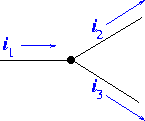 ,
,
The first law just restates what you already know about electrical potential: every point in a circuit has a unique value of the potential, so travelling around the circuit by any path must bring you back to the potential you started from. Using the analogy to elevation, if you hike from any starting point in the mountains and wander around by any choice of paths but finish at your original starting point, the sum of the elevation changes along your path will add up to zero.
The second law just restates the fact that electric charge is conserved: electrons or protons are not being created or destroyed in the node (or if they are, anti-particles with the opposite charge are being created or destroyed along with them) so in any given time interval, the charge that enters is equal to the charge the leaves. The node is assumed to have negligible capacitance, so charge cannot just build up there. For example, at a point where three wires are connected as in the diagram below, charge conservation requires that i1 = i2 + i3.

|